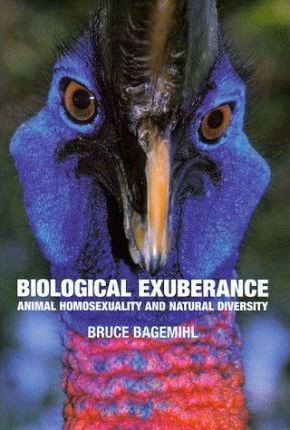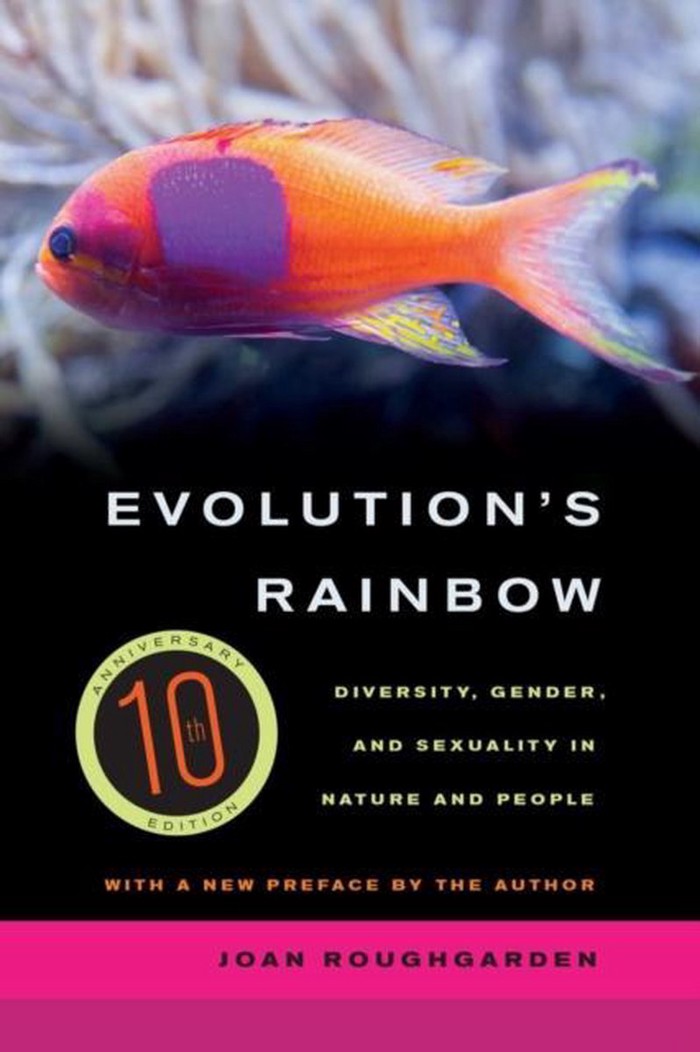Laurens Buijs
Amsterdam Gender Theory Research Team
Gender and sexuality diversity (LGBTTI) is still often portrayed as “a flaw of nature” or “contrary to Darwinian evolutionary biology.” This has all sorts of undesirable consequences for the public debate on gender, where co-essentialists and essentialists have become embroiled in a trench war. All the while, modern evolutionary theory has gained radical new insights about the role of diversity of sexuality and gender, making polarization unnecessary.
Structure of this blog
- Introduction
- Cultural assumptions in early Darwinian evolutionary biology
- Shifts in evolutionary biology
- Selection pressure on androgyny: humans as matriarchal species
- Conclusion: the evolutionary rainbow connects opposites
1. Introduction
Debates about gender and sexuality are becoming increasingly polarized, and ideas about evolutionary theory play an important role in that dynamic. Whereas co-essentialists see evolutionary theory as a t hreat to their ideological agenda about gender and sexuality as fundamentally social and socially engineerable, essentialists actually see in it an important support for theirs (see mission for more on the struggle between essentialism and co-essentialism).
Co-essentialists often stay far away from evolutionary biology. They rightly see that gender and sexuality are “social constructs” and that culture plays a major role in how we interpret and experience gender and sexuality. But they look away from the ways in which gender and sexuality as evolutionary phenomena also structure culture, and that, moreover, they create the frameworks within which social behavior is possible.
Essentialists, on the other hand, are quick to regurgitate all sorts of platitudes from traditional evolutionary biology. They correctly see that gender and sexuality are central ingredients of evolutionary biology and a fundamental force behind all complex life on earth that cannot be reduced to mere culture. But they fail to see that it is precisely the exuberant diversity in gender and sexuality that drives evolution.
Learn more about the basics of gender and sexuality:
What is gender anyway, and why is biological sex not sufficient?
2. Cultural assumptions in early Darwinian evolutionary biology
Co-essentialists and essentialists often share the same assumptions about Darwinian evolutionary thinking: evolutionary theory would seek to provide natural legitimacy for gender as innate, fixed and for sexuality as in the service of procreation (heterosexuality). This is why the co-essentialists like to stay away from it, while the essentialists like to bring it up.
However, these shared assumptions of co-essentialists and essentialists are now obsolete. Evolutionary biology has undergone a major development in recent decades, with gender and sexuality diversity being seen less and less as an aberration, but rather as the driving force behind the evolutionary process.
That traditional evolutionary biology had a considerable patriarchal and heteronormative bias is also evident in the work of Charles Darwin. Darwin was convinced of an exalted role for the man and for masculinity within the theory of evolution, as shown, for example, in this quote:
“The greatest difference in mental abilities between the sexes is reflected in this that the man reaches to a greater height in anything he tackles that requires deep thought, reasoning or imagination, or merely the use of the senses and hands.”
Charles Darwin
Early evolutionary theory was laced with traditional views of gender and sexuality, a reminder that scientific theories always arise in particular places and times. Scientists always produce knowledge in social networks and from paradigms that cannot be separated from cultural norms and values (see also the work of Bruno Latour).
3. Shifts in evolutionary biology.
Over the years, evolutionary biologists have come to see more and more cracks in traditional thinking about male and female, and evolutionary theory has been modified in some subtle yet fundamental ways that have shaken the assumptions mentioned above.
The focus within evolutionary biology has shifted within a number of fundamental debates about how evolution occurs. I discuss three such shifts in this blog: from scarcity to abundance, from selfishness to cooperation, and from hierarchy to equality.
3a. From scarcity to abundance
Biologist Bruce Bagemihl criticized back in 1999 the heteronormative lens through which biologists have traditionally viewed the animal kingdom. Mating behavior between two animals of the same sex has been frequently observed by peers for decades, but dismissed as an “mistake” or arising from lack of availability of conspecifics of the opposite sex.
According to Bagemihl, the many functions of sexuality that have nothing to do with procreation are therefore not valued. When he looks at the animal kingdom without this “double standard,” he sees in more than 450 species an exuberant diversity in terms of sexuality and gender that he maps in detail, through observations, photographs and drawings.

He posits the great diversity he observes not as an exception, but as a fundamental part of evolution. This diversity creates the possibility for endlessly complex social connections and relationships. Bagemihl thus contributed to the understanding that natural systems are not just about scarcity and efficiency, but just as much about diversity and exuberance.
3b. From selfishness to cooperation
Evolutionary biologist Joan Roughgarden elaborates on Bagdemihl’s argument in 2004. Also according to Roughgarden – a transwoman herself and inspired in her work by her personal experiences – sexuality in Darwin’s theories would revolve too much around procreation.
Roughgarden showed in her work that sexuality often has nothing to do with “selfish genes” seeking to secure one’s own reproduction. On the contrary, she observed that sexuality in animals often has a variety of social functions, such as bonding and communication through the exchange of physical pleasure. She therefore proposed replacing the concept of sexual selection with social selection.

Roughgarden initially received little acclaim. On the contrary, her colleagues undertook all sorts of attempts to falsify her theory. But after the tenth printing of her now widely cited book, the flag hangs very differently.
Although her concept of social selection is still not widely adopted, much less stereotypical assumptions are now made about male and female roles in sexual selection. Also, mating behavior between animals is no longer captured solely in terms of competition, and there is increasing attention to the importance of cooperation, altruism and empathy in animal sexual relationships.
3c. From hierarchy to equality
In addition, insights about the evolutionary forces behind the emergence of Homo sapiens in the African savannah have been honed in recent years. There is new evidence that selection pressure arose in humans and their predecessors to reduce sexual dimorphism, or physical difference between male and female. Smaller differences have promoted flexibility and cooperation. This has been argued in part by biologist Dennis Bramble, who gained fame in 2004 with a groundbreaking publication in Nature on what he calls the endurance running hypothesis.

What distinguishes humans and their ancestors from other primates, Bramble argues, is our ability to run: a hunting method in which prey animals are pursued for as long as necessary until they can be overpowered by exhaustion. This hunting method is characterized by complex cooperation with strategic role assignment, where endurance is key. According to Bramble, this hunting method was so central to our survival on the savannah that it largely determined our physiological development.
Equivalence is often seen in anthropology and biology as the result of reciprocity, or mutuality. This notion is quite often selfishly interpreted as “one good turn deserves another,” but should rather be understood as a mechanism to guard horizontal relationships and respect for the other’s equal position. This involves creating a balanced exchange in which all parties involved are treated and valued as equals.
Whereas hierarchy and a clear division of roles between male and female have played a major role in chimpanzees and gorillas, for example, the survival success of humans is instead due to increasingly horizontal structures and equal cooperation. Increasingly, survival strategies for which both female and male bodies are equipped were chosen. Men and women have converged in this evolutionary process: in humans, men are smaller and more feminine than, for example, in the great ape species and neanderthals.
4. Selection pressure on androgyny: humans as matriarchal species
Modern evolutionary-biological insights shed a different light on evolutionary biology. It was not strength and selfishness, but endurance, agility and cooperation in horizontal structures that brought our survival to safety. Humans managed to survive primarily through the evolutionary advantage of androgyny (see also AGTRT-BA1).
Read more about the androgynous core of man:
What we can learn about masculinity and femininity from hunters and gatherers
It is not so much the case that traditional evolutionary biology is completely wrong. Indeed, scarcity, hierarchy and selfishness are major driving forces behind the evolution of life on earth. But this does not tell the whole story. One might say that Darwin was projecting his own patriarchal culture of 19th century British class society onto nature, and so failed to see that all sorts of opposing elements play an equally important role, such as abundance, cooperation and equality.
Perhaps we can call the first group of evolutionary elements (i.e., scarcity, selfishness and hierarchy) “masculine” because they are all about differentiation in some way. Differentiation is what is seen in ABGT as the most abstract form of masculine quality. And perhaps we can and do call the second group of elements (i.e. abundance, cooperation and equality) “feminine ” because they are all about integration in some way. In ABGT, integration is seen as the most abstract form of feminine quality.
Humanity managed to survive and build spectacular global civilizations precisely because we were able to integrate the masculine and feminine aspects of existence. People are capable of building hierarchical institutions, but also of building in mechanisms through which power and participation are nevertheless redistributed fairly. We are capable of competition, but even then we prefer to work together in teams. We are challenged by scarcity, and use that as inspiration to create abundance.
In other words, man balances on the tightrope between differentiation and integration, using both extremes to achieve a new mix. This is what in ABGT is called transcendence, the most abstract form of the androgynous quality. Here we have arrived at ABGT’s central hypothesis: humans arose because of selection pressure for androgyny (see also AGTRT-BA1), and are thus at their core a matriarchal species (see also AGTRT-BA9).
5. Conclusion: the evolutionary rainbow connects opposites
Essentialists and co-essentialists may in the future be united in a new narrative of evolutionary biology that places androgyny at its center. In it, the diversity that co-essentialists point to is the driving force behind the survival success of species like humans. And essentialists see in this their views of gender and sexuality as more than social constructs: after all, the endless complexity of the evolutionary rainbow is made possible by the stunning simplicity of the duality between masculinity and femininity (see also AGTRT-BA8).

Leave a Reply